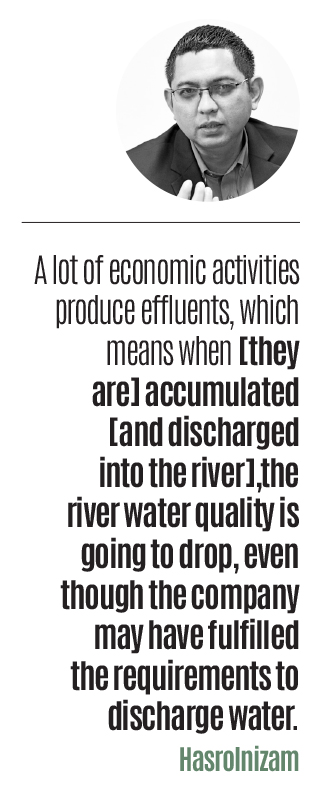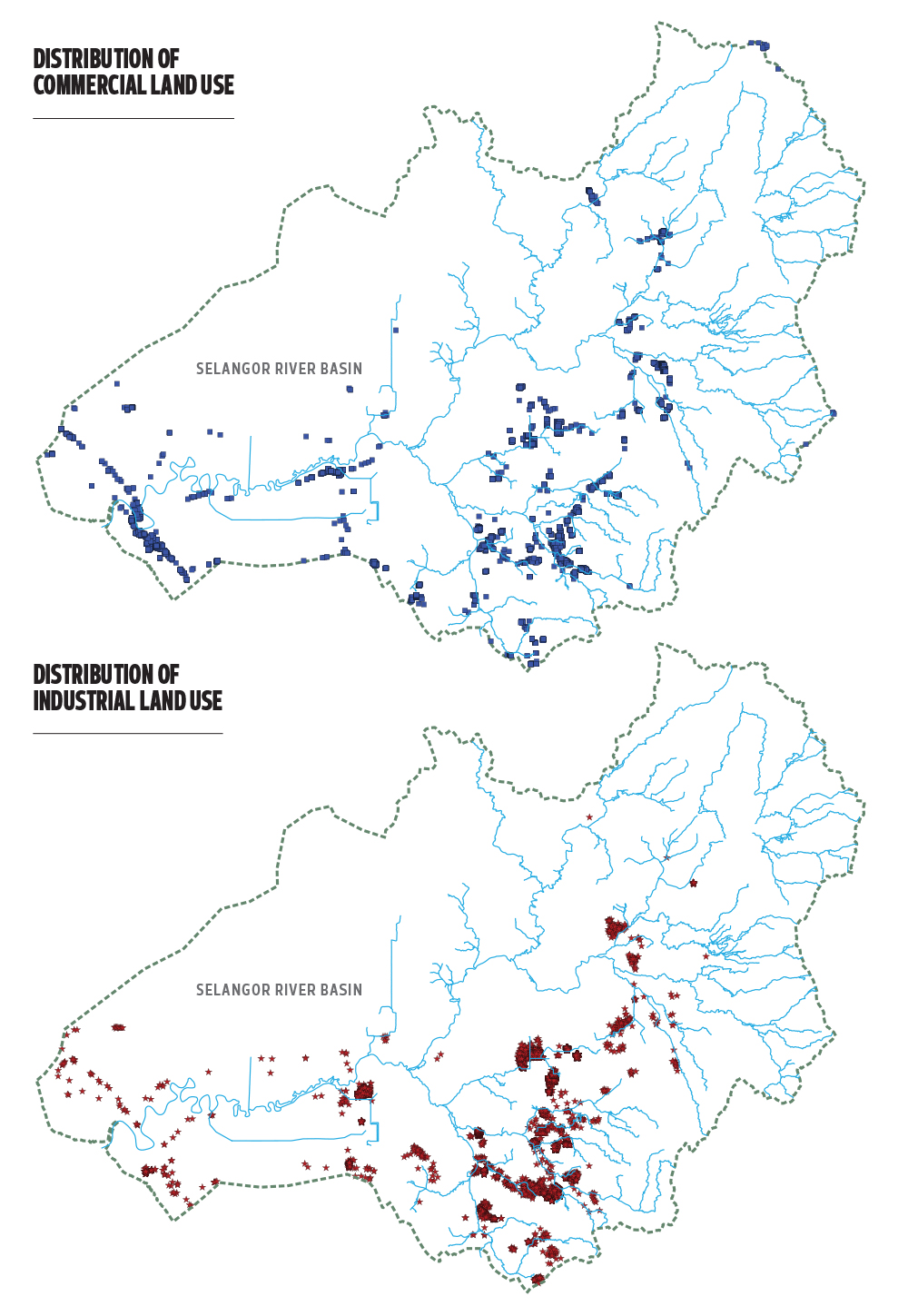
This article first appeared in The Edge Malaysia Weekly on August 22, 2022 - August 28, 2022
Consumers use water for daily activities like washing and cleaning, apart from drinking. More often than not, the water used for these activities can be reused for other purposes, such as to water plants.
This also holds true for businesses. The amount of water discharged by businesses, whether it is from washing, cooling, cleaning or other processes, is relatively huge compared with households. The wastewater is typically discharged to the nearest drains, which eventually feed into rivers.
An estimated 30% of river flow volume comes from effluent discharged from industrial, commercial and daily human activities, according to the Selangor Water Management Authority (SWMA, or more commonly known as LUAS).
Problems occur when the water discharged is contaminated with effluents to a point that it is difficult — and expensive — to be treated.
According to the National Water Resources Study by Pengurusan Air Selangor Sdn Bhd (Air Selangor), the cost of treating river water to become potable water is estimated to be RM2.31/m3, depending on the type of treatment.
A growing population, rapid economic development, the threat of climate change and illegal dumping of waste into rivers by irresponsible parties of late have increased the urgency to ensure clean water supply for the current and future generations. Residents of the state have had to contend with water cuts multiple times in the past few years because of these incidents.
The best way for LUAS to cut down on the cost, time and effort to treat discharged water is to reduce the effluent discharge or eliminate water discharge altogether, says Hasrolnizam Shaari, director of LUAS.
That is why LUAS is introducing a zero-discharge policy (ZDP). Its main objective is to get all parties, especially small and medium-size enterprises (SMEs), to reduce the amount of water and effluents discharged into rivers. Currently, around 99% of businesses in the state are SMEs, he says.
“A lot of economic activities produce effluents, which means when [they are] accumulated [and discharged into the river], the river water quality is going to drop, even though the company may have fulfilled the requirements to discharge water,” Hasrolnizam adds.
To maintain a river’s water quality at the optimal level, the dilution factor for the river, which is dependent on its volume, is considered. A large river has a relatively higher dilution factor than a smaller river, so it can accommodate or assimilate higher levels of pollutants.
For example, effluent discharge of 40mg/l of biochemical oxygen demand (BOD5) from one factory will have a bigger impact on the water quality of a small river compared with a large one.
“[The] existing standard parameters are based on [effluent] concentration, so the impact on a river’s water quality is different, depending on the dilution factor,” Hasrolnizam says.
It can be inferred, then, that with population growth and rising economic development, existing rivers may not be able to handle the growing levels of effluents being discharged, since the volume of the rivers remain the same.
Why is the ZDP needed?
LUAS hopes that with the ZDP in place, water sabotage incidents and the subsequent water cuts in Selangor will be reduced in the long run. The state’s population and water usage are so high that in the event a water treatment plant is shut down, it takes only three hours for water reserves to be drained. The process of refilling the reserves, however, takes longer — sometimes more than 24 hours.
“This is why when there is some sort of pollution [incident], water cuts can last more than a day because to ‘rescue’ the water takes time. Channelling clean water to homes takes even longer,” Hasrolnizam says.
He adds that in the past, water was extracted from areas that were not developed and thus, had cleaner raw water. That’s why water treatment plants are generally located at the upstream of rivers. However, these areas are now developed and LUAS needs to find alternative sources of water.
“We have people stationed 24 hours at the main rivers to ensure that the water quality is under control. It’s not easy to manage because these people use their noses to sniff out pollutants in the water. Even when there is the slightest hint of pollution, the water cannot be used and we need to treat it,” he explains.
With the ZDP, Hasrolnizam says river pollution will be managed and controlled. Nowadays, the state is seeing rapid economic development around the river basins. It is also facing the uncertain effects of climate change.
“By right, all rivers should only receive natural water or water runoff from groundwater. But the situation in Selangor is such that all the rivers have economic activities happening in the surrounding areas.
“This means that for some of the rivers, at least 30% of the water volume is discharged water from activities. The water in Sungai Penchala, for example, is more than 80% made up of used water from the surrounding activities,” Hasrolnizam explains.
Despite the concern over the declining water quality, Hasrolnizam says Selangor residents are lucky because the rivers are still in good condition even though almost all have economic activities in their vicinity.
Selangor has seven rivers. Hasrolnizam says the state extracts 5,000 million litres of water per day from rivers, and this goes through 34 water treatment plants. This amount is equivalent to the amount of water used by all the other states in the peninsula combined.
Based on a report by the Department of Environment (DOE), the water quality at all seven river basins showed a positive trend every year from 2018 until March 2022. Four river basins are in the “clean river” category and three are in the “slightly polluted” category.
As at December 2021, 82% of rivers in Selangor were in Class I and II, which means that the water is still in good condition.
Implementation of ZDP
Under the ZDP, companies will need to pay a fee to discharge water into rivers. The more the discharge, the higher the fee. This means that all parties subject to the ZDP will need to plan their activities in order to reduce or completely eliminate water discharge.
The fee that is to be paid depends on the amount of effluent discharged into water sources. The proposed rates are between RM0.10/m3 and RM0.20/m3, depending on the volume discharged. It will be calculated every month.
The quality of the water discharged also needs to be within the acceptable standard, Hasrolnizam explains. If the water discharged does not follow the parameters and standards under the ZDP, they will be fined via the polluter’s pay principle.
Hasrolnizam says the common perception is that pollution comes from large companies. However, when accumulated, small companies or activities by actors like markets, restaurants and car wash operators, also become significant sources of water discharge.
“If they don’t want to pay a fee, they need to take precautions to control the discharge. Sometimes, it involves tech instruments. Activities that release more than 60 cu m of water a day will need to apply for a discharge licence under the ZDP.
“Any [operator with discharge volumes] below that will not need a licence but they will be charged a reasonable monthly fee. The same thing applies to the quality of water discharged. This is how we are looking to cover any loopholes or grey areas that are not covered by other federal policies. If they do not fall under the DOE’s jurisdiction, they fall under the ZDP,” says Hasrolnizam.
There are four big clusters when it comes to the production and release of water: industrial; development activities; agriculture, farming and livestock activities; and municipal activities.
Hasrolnizam stresses that the ZDP is a policy to encourage water management. With that in mind, he says LUAS wants to get industry players familiar with it first before mandating licence applications.
For example, when the licensing requirement for restaurants sets in, they will need to submit water samples for testing to ensure that the quality is within the stipulated parameters. As for the volume of discharge, meters will be installed to track it.
“The money that we collect from enforcement activities will be used to treat water, not just in the respective area [of the businesses], but along stretches of the river as well,” he says.
“SMEs have already given us feedback on the amount they can afford to pay monthly without passing on the charges to the customer, so we will decide on the appropriate monthly amount to charge SMEs for water discharge soon.”
The ZDP will need to be tabled and approved by the Selangor exco’s State Executive Council Meeting (MMKN) through the Selangor Economic Action Council (MTES). Once approved, it will be part of the state’s law.
Hasrolnizam says the ZDP proposal was approved at a LUAS board meeting chaired by Selangor Menteri Besar Datuk Seri Amirudin Shari in January. A series of town hall engagements with relevant parties have also been carried out.
The ZDP has been presented to two committees chaired by the Selangor State Government Secretary and Selangor State Legal Advisor. The ZDP regulation is expected to be presented at the MTES Meeting for approval in August.
Save by subscribing to us for your print and/or digital copy.
P/S: The Edge is also available on Apple's App Store and Android's Google Play.


